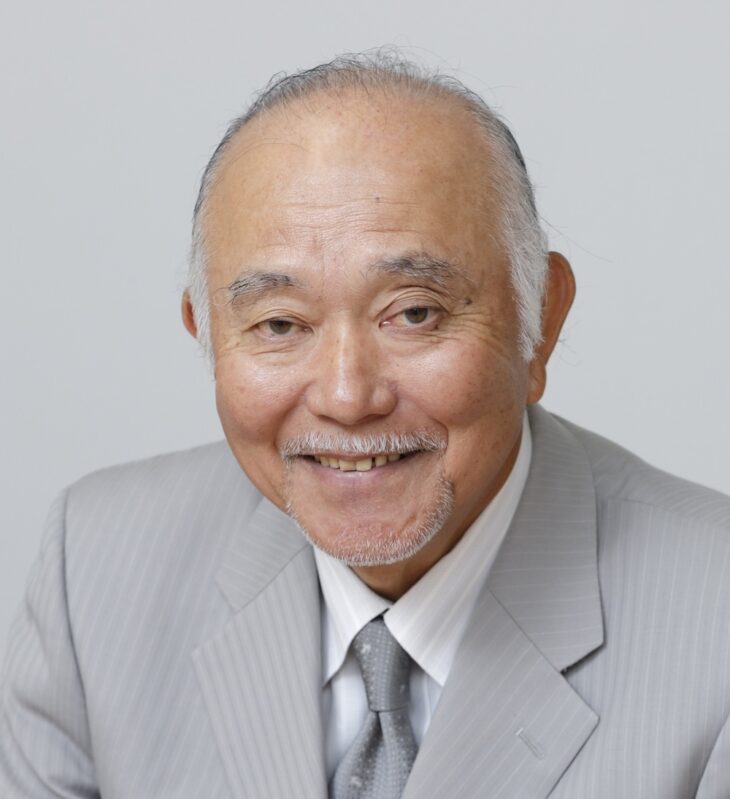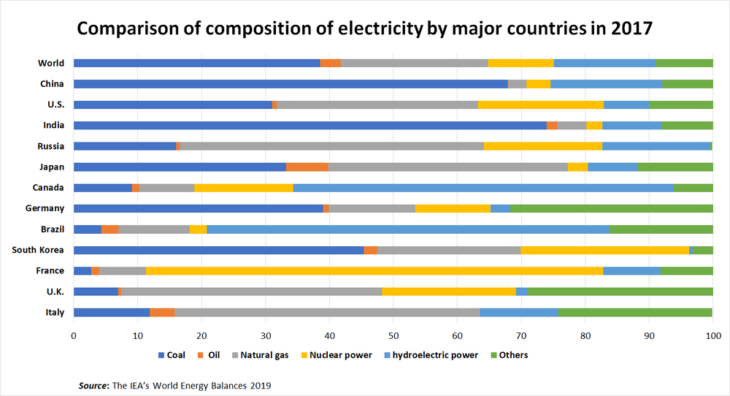Challenges to Power Source Optimization (I): Ensuring that a Broad Range of Choices, Including Nuclear Power, Are Available
Kashiwagi Takao, Distinguished Professor at the Tokyo Institute of Technology
Key points
- Stable supply is the most important energy policy
- Play a leading role in the development of innovative technologies to promote decarbonization
- Choosing either renewable energy or atomic energy is not a solution

Prof. Kashiwagi Takao
The basic policy for phasing out inefficient coal-fired power plants presented on July 3 by Kajiyama Hiroshi, the Minister of Economy, Trade and Industry, was shocking. Japan’s energy policy is based on the “3Es+S” concept which holds that efforts should be made from the perspectives of the 3Es, energy security, the economy, and environmental conservation, based on the assumption of the maintained safety of atomic energy.
The demand for electricity, while showing a temporary decrease due to COVID-19, has been increasing consistently by 2.6–3.5% globally since 1980. Global electricity demand grew to 2.7 times the 10 trillion kWh in the 90s to 27 trillion kWh in 2019. In particular, demand grew to more than four times its previous level in many Asian countries. Coal-fired thermal power is the main factor contributing to this growth trend, which is expected to continue going forward.
The figure shows the composition of electricity by source in 2017 from an international point of view. Globally, slightly less than 40% of electricity is from coal-fired thermal power. Ten European countries that committed to abolishing coal-fired thermal power by 2030, including France, Italy and the UK, are characterized by an extremely small percentage of their electricity coming from coal-fired thermal power. Energy policy is itself a national strategy. Countries therefore implement policies strictly in line with domestic conditions while considering national interest.

The challenge faced by the power system is the generation of power in line with the demand curve. In other words, the principle of balancing supply and demand applies. Generating too much power leads to an increase in the voltage of power grids. Particularly, sunlight and wind, renewable energy sources whose outputs are unstable due to climate conditions, frequently fluctuate which may result in power outages if the fluctuations do not stay within a certain range. To say this another way, voltage can be compared to a person’s blood pressure and frequency to this person’s pulse. It is impossible to stay healthy with high blood pressure or arrhythmia.
Understanding these basic characteristics of electricity, it becomes clear that the most important issue for energy policy to address is stable supply, as mentioned earlier. Stable supply depends fundamentally on the base power sources that consistently supply a fixed amount of electricity. Globally, these are mainly coal and atomic energy. In emerging countries in the process of industrialization, a stable supply of electricity cannot be achieved without low-cost base power sources.
That said, The world is divided in its evaluation of coal-fired thermal power because it generates a great deal of CO2. Many countries, including European countries, are accelerating efforts to end the use of coal with the goal of decarbonization, while India and other Asian countries prioritize coal-fired thermal power, and coal is a large percentage of the energy they generate. At the same time, a not-insignificant number of countries including Vietnam and Indonesia are eager to build cutting-edge efficient coal-fired thermal power generation systems.
Japan, an advanced Asian country, has decided to abandon inefficient coal-fired thermal power and maintain its supply of electricity with new, efficient coal-fired thermal power, with a view toward a decarbonized society. This is a reality-oriented approach.
I think that it is important that each country makes the most of its own characteristics to facilitate the stable supply of energy. I strongly believe that, with an eye on a decarbonized society, Japan should play a leading role in the development of innovative technologies while simultaneously maintaining every power generation option without abandoning the option of maintaining primary energy. I have no objection to Japan phasing out inefficient coal-fired power plants while continuing to use integrated gasification combined cycle (IGCC) power generation systems. However, it is not clear what measures should be taken to make up for the decrease in base power sources resulting from this phasing out process. Energy-saving measures such as next-generation energy management systems are effective but quantitatively insufficient. We should consider these measures from every perspective, including the perspective of supply sources.
Replacing coal-fired thermal power with renewable energy by accelerating efforts to make renewable energy a main source of electricity is good from the perspective of CO2 reductions. Solar and wind power can be increased quantitatively in the future because their marginal cost is almost zero. Even so, as described earlier, there are many issues that need to be addressed, including instability. These sources of energy may be within a free-rider perspective but the issues preventing their use as base power sources are serious.
The remaining option is nuclear power. Nuclear power is an effective measure for decarbonization and contributes to self-sufficiency improvements. If the existing nuclear power plants resume operations after meeting the world’s strictest standards, there is no doubt that nuclear power can be a base power source because the cost of nuclear power generation is lower than fossil fuels. Internationally, the International Energy Agency (IEA) has expressed its view that the stable supply of power is recognized as being even more important during the COVID-19 pandemic, and based on this, it has positioned nuclear power as an important power source underpinning a stable supply of power.
China, the US, the UK, and other countries have established policies increasing the use of nuclear power. It appears that the US and the UK are seeking to commercialize small nuclear reactors. The US is actively supporting the startup-headed International Project on Innovative Nuclear Reactors and Fuel Cycles in which operations are projected to start in 2026. Additionally, the UK is supporting Rolls-Royce’s development of small nuclear reactors. These efforts demonstrate that nuclear power generation has entered a new phase.
In Japan, the public’s distrust of nuclear power is high, even nine years after the incident at the Fukushima No. 1 nuclear power plant. It is too early to say that national consensus has been established in conjunction with the 3Es+S concept underlying energy policy. Studies for the creation of a strategic energy plan have begun, and the issue is expected to be assessed from multiple perspectives.
It is impossible to envision the future of Japan as a technology-oriented country unless the country seeks to commercialize comprehensive engineering technologies, such as atomic energy. As a scientist, I am very eager to find a solution that increases Japan’s national power and achieves its interests. However, it is extremely difficult to find a solution if we are choosing either renewable energy or atomic energy.
To realize a decarbonized society, Japan should promote innovation ahead of other countries to ensure it is able to tap every power source option. Early this year, the government announced the Progressive Environmental Innovation Strategy. The strategy, which selected 39 themes for 16 challenges in 5 areas were from a range of perspectives, was formulated based on the assumption that Japan would take a leading role in the facilitation of the development of technologies that realize a decarbonized society. It drew a lot of attention. The government says that if these innovative technologies are widely adopted globally, it is possible to reduce global CO2 emissions by approximately 4.9 billion tons, the amount emitted globally every year or more.
In other words, it featured a Beyond Zero slogan that aspired for the reduction of CO2 beyond the amount that has been emitted to date, showing the direction that Japan, an energy resource-poor nation, will move in going forward, to contribute to the world.
Five areas, non-fossil fuel energy, energy network, hydrogen, carbon capture use and storage (CCUS) and smart agriculture, were selected, on which concrete themes were presented respectively. I think that Japan can play a leading role in the areas of hydrogen, storage batteries and CCUS. We should not be affected by the narrow way that environmental fundamentalists think, in which non-fossil energy sources are the only solution for the creation of a decarbonized society. It is important that each country including emerging countries seeks to accelerate de-carbonization by systematically introducing technology according to their own domestic situation.
The Tokyo Zero-emission Innovation Bay was established in June as the world’s first CO2 Zero base to verify these innovative technologies in Japan.
I have no objection whatsoever to decarbonization. Decarbonization is a global issue, However, it is extremely important that each country makes use of every technological option available instead of abandoning options for primary energy, to enable every country to develop a decarbonization-oriented strategy in consideration of its national interest and conditions at its own discretion.
Translated by The Japan Journal, Ltd. The article first appeared in the “Keizai kyoshitsu” column of The Nikkei newspaper on 18 August 2020 under the title, “Dengen-kosei Saitekika eno Kadai (I): Genpatsu wo fukume sentakushi habahiroku (Challenges to Power Source Optimization (I): Ensuring that a Broad Range of Choices, Including Nuclear Power, Are Available).” The Nikkei, 18 August 2020. (Courtesy of the author)
Keywords
- Kashiwagi Takao
- Tokyo Institute of Technology
- power sources
- nuclear power
- coal-fired power
- decarbonization
- innovative technologies
- 3Es+S
- International Project on Innovative Nuclear Reactors and Fuel Cycles
- Progressive Environmental Innovation Strategy



